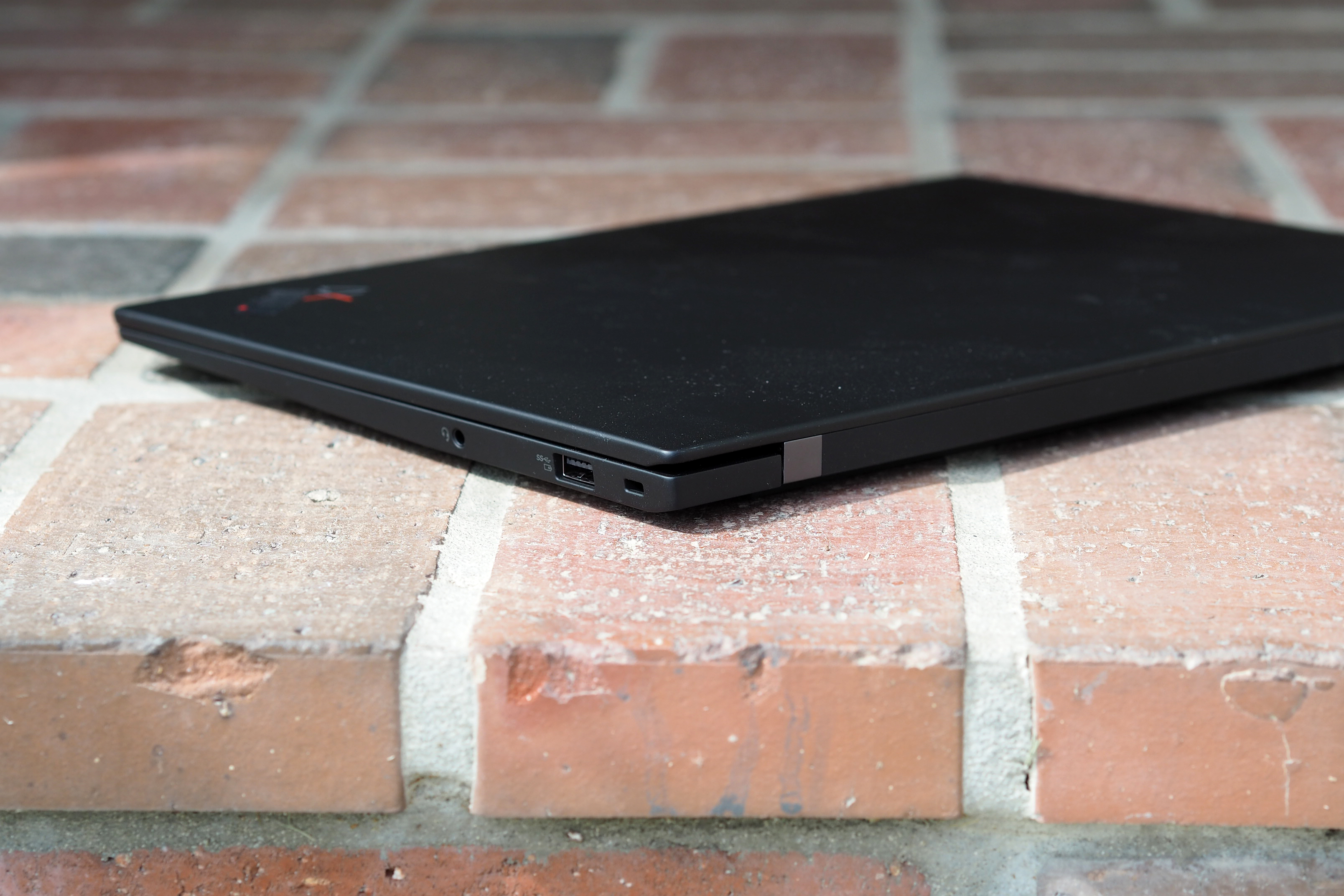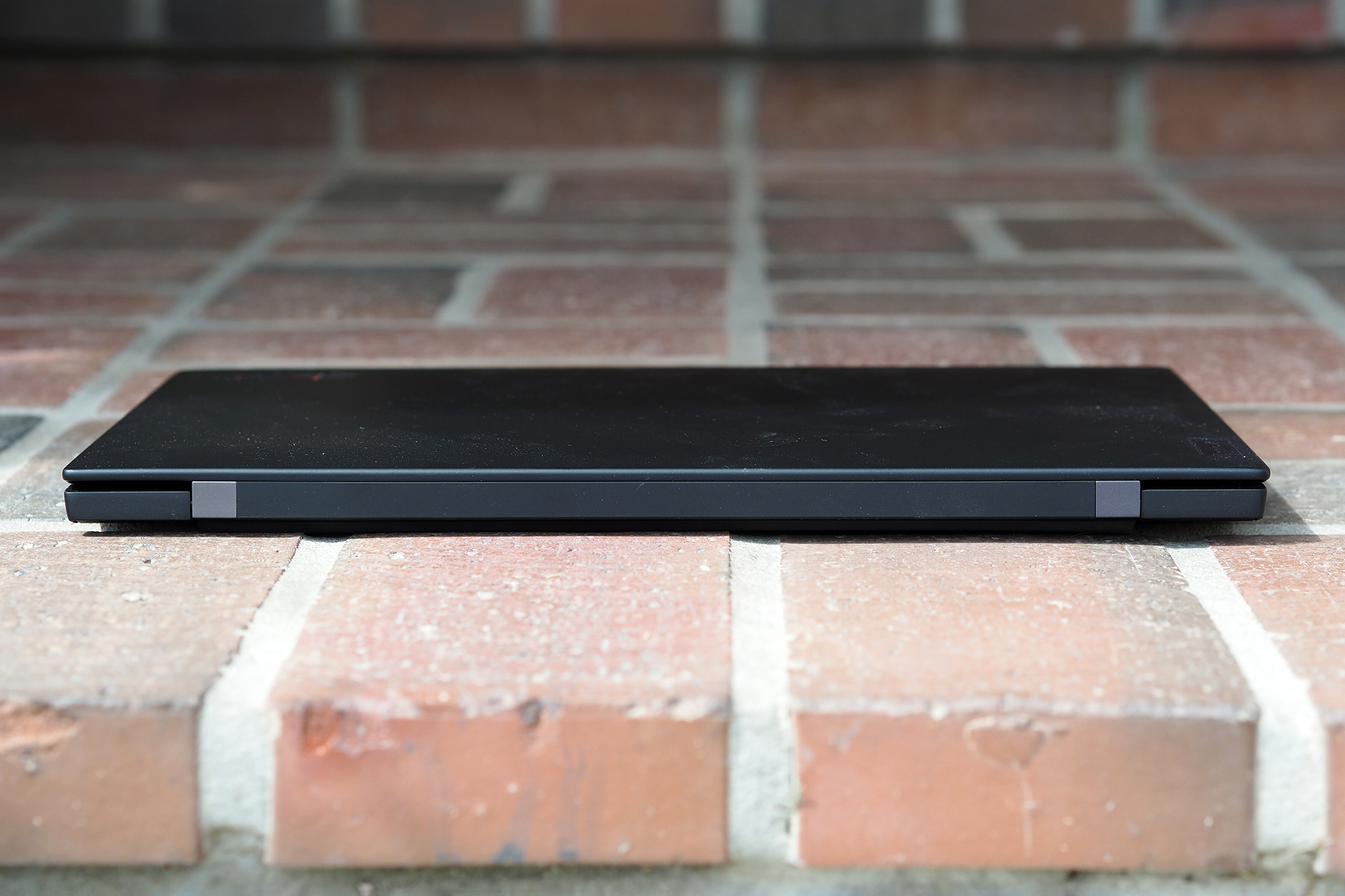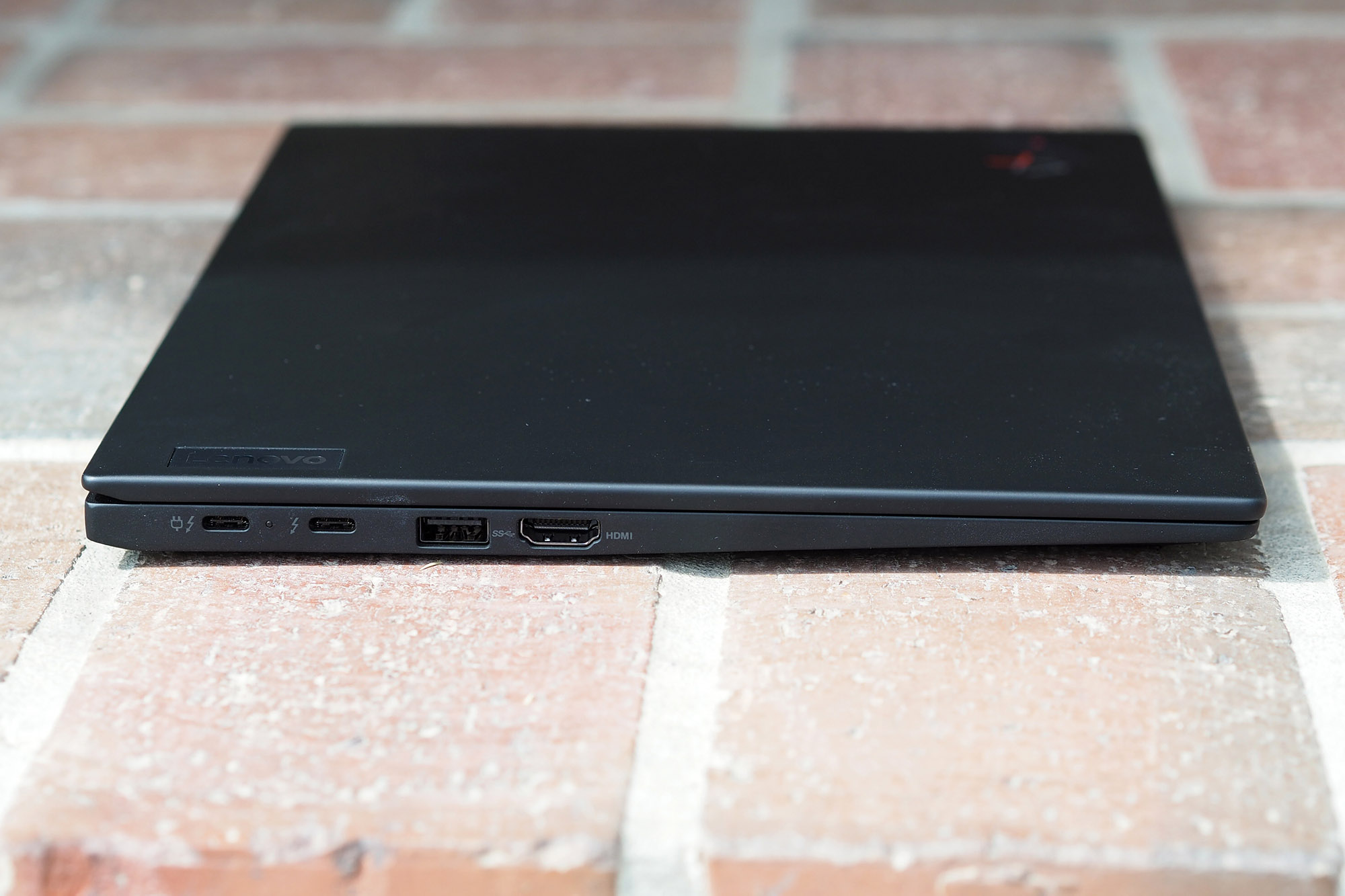“The Lenovo ThinkPad X1 Carbon, now in its ninth generation, remains one of the very best high-end business laptops.”
- Elegant look and feel
- Solid productivity performance
- Incredibly long battery life
- Excellent keyboard
- Long list of business-friendly features
- Expensive
- A little flexible
By the time a laptop has reached its ninth generation, you expect it to be refined. That’s particularly true of Lenovo’s ThinkPad X1 line, which has entries that are among the best business laptops. The ThinkPad X1 Carbon is the flagship of the series, and the ninth generation promises to retain that refinement while making some meaningful changes to its design — including a switch to a 16:10 display aspect ratio.
I reviewed a $1,865 configuration of the ThinkPad X1 Carbon Gen 9, with an 11th-gen Intel Core i7-1165G7 CPU, 16GB of RAM, a 512GB PCIe solid-state drive (SSD), and a non-touch 14-inch IPS full HD+ (1920 x 1200) display. The spec bump, 16:10 screen, and excellent battery life are all welcome changes that keep the ThinkPad X1 Carbon among the best business
Design
Besides the necessary change in dimensions to accommodate the taller display, Lenovo didn’t alter much with the ThinkPad X1 Carbon’s design. It’s still constructed of a carbon fiber lid and magnesium alloy throughout the rest of the chassis, which makes it lightweight while at the same time giving it some bend in the lid and flex in the keyboard deck. It’s not so much as to make you doubt its durability, but it doesn’t feel as rock-solid as

In fact, I should stress that the ThinkPad X1 Carbon Gen 9 feels great in hand. It’s light at 2.49 pounds and thin at 0.59 inches. The XPS 13 comes in at 2.64 pounds and 0.58 inches, but, of course, it’s a 13-inch laptop and so feels quite a bit denser. The Spectre x360 14 is closer in size to the ThinkPad, and it’s 0.67 inches thick and weighs 2.95 pounds. There’s something beyond these technical specs, though, that makes the ThinkPad X1 Carbon so comfortable to carry around — it’s a well-executed combination of the weight, thinness, and soft-touch feel. Simply put, the laptop exudes quality. A minor complaint is that the top and bottom display bezels are larger than they could be, which slightly increases the laptop’s overall size. It’s not a major problem, but some other modern
Lenovo updated the hinge on the latest model, creating a single-hinge design that incorporates the wireless antennas inside. I found the hinge to be excellent, allowing the lid to be opened with one hand while avoiding any display wobble while typing. It rivals the XPS 13’s smooth hinge, one of the best for a couple of generations.
The ThinkPad X1 Carbon Gen 9’s aesthetic remains the same, with the usual ThinkPad black-on-black design with a few red accents in the LED above the “i” in the ThinkPad logo, the “X” in the X1 logo, the red TrackPoint nubbin in the center of the keyboard, and along the bottom edges of the TrackPoint buttons. It’s an iconic look and feel that should be familiar to ThinkPad lovers and that provides an elegant yet conservative aesthetic for everyone else. The XPS 13 and Spectre x360 14 offer more complex and colorful designs, while the Dell Latitude 7420 offers another conservative look that might appeal to business users.
Connectivity is strong for such a thin laptop. Along the left-hand side, there are two USB-C ports with Thunderbolt 4 (one of which is used to charge the laptop), a USB-A 3.2 port, and a full-size HDMI 2.0 connection. On the right-hand side, there’s another USB-A 3.2 port and a 3.5mm audio jack. Unfortunately, there’s no SD card reader. If you configure the optional 4G/
Performance
The ThinkPad X1 Carbon Gen 9 can be configured with various 11th-gen U-series CPUs, from the Core i5-1135G7 to the Core i7-1185G7, with Intel vPro as an option. My review unit was equipped with the Core i7-1165G7, a competent processor that typically provides excellent productivity performance. You can use the Windows 10 performance slider to engage Lenovo’s standard and performance modes, but I didn’t see much of a difference in our benchmarks. In fact, the performance mode caused some slower scores, perhaps because the laptop’s thermals couldn’t keep up. The only significantly improved score was the single-core Geekbench 5 result, which came in at 1,556 versus 1,327 in standard mode.
Compared to a comparison group of identically configured
I found the ThinkPad X1 Carbon Gen 9 to live up to these benchmark results in real-world use. It was a speedy laptop during my testing no matter what I threw at it — if my tasks were productivity-oriented. Like all
| Geekbench 5 (single/multi) | Handbrake (seconds) | Cinebench R23 (single/multi) | PCMark 10 | 3DMark Time Spy | |
| Lenovo ThinkPad X1 Carbon Gen 9 (Core i7-1165G7) | 1327/5201 | 170 | 1469/4945 | 5147 | 1776 |
| Framework Laptop (Core i7-1165G7) |
1432 / 4725 | 176 | 1444 / 5373 | 5054 | 1641 |
| Dell XPS 13 (Core i7-1165G7) | 1540 / 5432 | 201 | 1399/4585 | 3859 | 1589 |
| HP Spectre x360 14 (Core i7-1165G7) | 1214 / 4117 | 236 | 1389 / 3941 | 4728 | 1457 |
| Samsung Galaxy Pro 360 (Core i7-1165G7) |
1554 / 5603 | N/A | 1308 / 4062 | 5159 | 1800 |
| Razer Book 13 (Core i7-1165G7) | 1548 / 5374 | 210 | 1508 / 4519 | 4878 | 1776 |
The ThinkPad X1 Carbon Gen 9 did well in the 3DMark Time Spy test, faster than most Intel Iris Xe
Display
According to my colorimeter, Lenovo chose a good display that doesn’t quite achieve greatness.
The move to taller displays with 16:10 and 3:2 aspect ratios versus the old-school 16:9 continues, with most premium

According to my colorimeter, Lenovo chose a good display that doesn’t quite achieve greatness. It just exceeded our 300-nit threshold for brightness at 306 nits, meaning it will be bright enough for all but direct sunlight. Colors were reasonably wide at 76% of AdobeRGB and 96% of sRGB. That’s a little higher than the premium average for the former and average for the latter. Color accuracy was excellent at a DeltaE of 0.99 (less than 1.0 can’t be discerned with the human eye).
Those results are mixed compared to some other premium
My subjective analysis matched these objective results. I found the display to be bright and colorful without being oversaturated, and the contrast was high enough that black text jumped out on white backgrounds. This is a great display for productivity use but won’t meet the needs of creative professionals who demand wider colors. The taller aspect ratio is welcome, but I did miss touch support.

Audio is provided by two speakers to the left and right of the keyboard, along with two downward-firing woofers intended to add bass and extend the sound’s dynamic range. Dolby Atmos support promises improved spatial effects. I found the sound to be more than loud enough, with zero distortion at maximum volume. Mids and highs were crisp and clear, and there was just a touch of bass. The audio wasn’t up to the standard of the Apple MacBook, but it was better than many other premium
Keyboard and touchpad

The ThinkPad X1 Carbon Gen 9 has the typical ThinkPad keyboard with sculpted keys, excellent spacing, and deep travel. Normally, I find ThinkPad switch mechanisms a bit stiff for my tastes, requiring too much pressure to depress a key and causing fatigue over time. This one was softer and more comfortable — I don’t know if that’s a change to the mechanism or just how this specific keyboard turned out. I’d love it if this were something new that we’ll be seeing on other ThinkPads because I like this keyboard much better. It’s close to the keyboard on my favorite Windows 10
There’s the usual ThinkPad TrackPoint nubbin in the middle of the keyboard, and it works as usual. If you like that form of cursor control, then you’ll like this one just fine. The downside to the TrackPoint is that it requires an extra set of buttons, which takes space away from the touchpad. Lenovo increased the width of the ThinkPad X1 Carbon Gen 9’s touchpad by 10%, but it’s still smaller than it could be. It’s a Microsoft Precision touchpad, though, and so it’s smooth and precise.
Security and privacy
The ThinkPad X1 Carbon Gen 9 is a business-class laptop, as much as it also appeals to consumer users. As such, it includes several features that make it attractive to organizations that want to enhance the security, privacy, and manageability of their laptop fleets.
First, there’s support for Intel’s vPro, a CPU feature that provides additional security and manageability capabilities, including Intel Hardware Shield and enhanced remote management. Next, the ThinkPad X1 Carbon Gen 9 incorporates Lenovo’s ThinkShield suite of security features, including the ThinkShutter webcam privacy switch, match-on-chip fingerprint reader for Windows 10 Hello password-less login, and a self-healing BIOS that can help avoid a system failure in the case of attack or corruption.
The ThinkPad X1 Carbon Gen 9 also supports Lenovo’s human presence detection (HPD) functionality. This uses an optional infrared camera (also used for Windows 10 Hello support via facial recognition) and impulse radar to sense when a user is in front of the laptop or steps away. In the latter case, the laptop is put to sleep, and when the user returns, it wakes up and logs in. My review unit wasn’t equipped with HPD, but I’ve used it on other ThinkPads, and it worked reliably and quickly.
Overall, the ThinkPad X1 Carbon Gen 9 continues Lenovo’s excellent support for business users. None of these features detract from the laptop’s attractiveness to consumers, but they make the laptop a much more enticing option for larger organizations.
Battery life

Not only is the reviewed display full HD+, which promises better battery life, but it’s also a low-power display. Combined with the jump in the ThinkPad X1 Carbon Gen 9 from 51 watt-hours of battery capacity to 57 watt-hours, I was given hope that Lenovo finally produced a ThinkPad with good battery life. Our experience with past ThinkPads hasn’t been the best in this department.
Lenovo leveraged the extra battery capacity and the low-power display to accomplish some excellent battery life.
My expectations were exceeded. In our web browsing test, the ThinkPad X1 Carbon Gen 9 went for just over 11.5 hours, a strong score that beats out the 10 hours or so that we consider to be a very good score. The Dell XPS 13 full HD+ managed just 8.5 hours, while the ThinkPad X1 Titanium Yoga lasted just over 9.5 hours. In our video test that loops a local full HD Avengers trailer, the ThinkPad achieved a phenomenal 20.5 hours, one of the best scores we’ve recorded, compared to the XPS 13 at 12 hours and the X1 Titanium Yoga at 15.75 hours.
The ThinkPad X1 Carbon Gen 9 also did exceptionally well in the PCMark 10 Applications battery benchmark, going for 17.25 hours. That’s the second-longest result in our database behind the LG Gram 16‘s extra half hour. The ThinkPad also did well in the PCMark 10 Gaming battery benchmark, at 4.75 hours. That’s again the second-longest score we’ve seen behind only the LG Gram 16, which lasted for just 11 minutes longer.
Clearly, Lenovo leveraged the extra battery capacity and the low-power display to accomplish some excellent battery life. Finally, we can report that a ThinkPad will last you not only a full day’s work but well into the evening. You might even have some power left over for the next day, depending on your workload. That’s a refreshing result that we hope carries over to the rest of the ThinkPad line.
Our take
The ThinkPad X1 Carbon Gen 9 is the best version of this laptop yet. As always, it exudes quality and is a joy to use, thanks to a soft-touch feel and a great keyboard. But thanks to the 16:10 aspect ratio display, solid productivity performance, and the best battery life we’ve seen in a ThinkPad, Lenovo has also made some meaningful improvements in this year’s model.
It’s expensive, but you get your money’s worth. It’s great for businesses, but don’t pass it up if you’re a consumer buyer. It’s a great laptop for anyone.
Are there any alternatives?
The Lenovo ThinkPad X1 Titanium Yoga is a great alternative if you’re not the biggest fan of the typical ThinkPad aesthetic. Its battery life isn’t as good, but its build quality is better and has its own charm.
If you want a detachable tablet, then Lenovo’s ThinkPad X12 Detachable is a solid choice. It’s not as fast or as long-lasting, but it’s the best detachable tablet you can buy.
Finally, if you don’t need the business features and want a slightly smaller laptop, then the Dell XPS 13 is always a good option. It’s still the
How long will it last?
The ThinkPad X1 Carbon Gen 9 is well-built enough to last for years, as promised by its military certification testing. It’s up to date in its components and should keep up with anyone’s performance needs for just as long. The one-year warranty is disappointing for an expensive business-class laptop.
Should you buy it?
Yes. The ThinkPad X1 Carbon Gen 9 is an excellent laptop that both consumers and business users will love.







